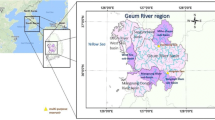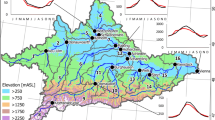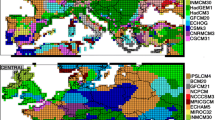Abstract
Given the ever increasing number of climate change simulations being carried out, it has become impractical to use all of them to cover the uncertainty of climate change impacts. Various methods have been proposed to optimally select subsets of a large ensemble of climate simulations for impact studies. However, the behaviour of optimally-selected subsets of climate simulations for climate change impacts is unknown, since the transfer process from climate projections to the impact study world is usually highly non-linear. Consequently, this study investigates the transferability of optimally-selected subsets of climate simulations in the case of hydrological impacts. Two different methods were used for the optimal selection of subsets of climate scenarios, and both were found to be capable of adequately representing the spread of selected climate model variables contained in the original large ensemble. However, in both cases, the optimal subsets had limited transferability to hydrological impacts. To capture a similar variability in the impact model world, many more simulations have to be used than those that are needed to simply cover variability from the climate model variables’ perspective. Overall, both optimal subset selection methods were better than random selection when small subsets were selected from a large ensemble for impact studies. However, as the number of selected simulations increased, random selection often performed better than the two optimal methods. To ensure adequate uncertainty coverage, the results of this study imply that selecting as many climate change simulations as possible is the best avenue. Where this was not possible, the two optimal methods were found to perform adequately.







Similar content being viewed by others
References
Arsenault R, Malo JS, Brissette F, Minville M, Leconte R (2013) Structural and non-structural climate change adaptation strategies for the Péribonka water resource system. Water Resour Manag 27(7):2075–2087
Brekke LD, Miller NL, Bashford KE, Quinn NWT, Dracup JA (2004) Climate change impacts uncertainty for water resources in the San Joaquin River Basin, California. J Am Water Resour Assoc (JAWRA) 40(1):149–164
Cannon AJ (2015) Selecting GCM scenarios that span the range of changes in a multimodel ensemble: application to CMIP5 climate extremes indices. J Clim 28:1260–1267
Chen J, Brissette FP, Poulin A, Leconte R (2011a) Overall uncertainty study of the hydrological impacts of climate change for a Canadian watershed. Water Resour Res 47:W12509. doi:10.1029/2011WR010602
Chen J, Brissette FP, Leconte R (2011b) Uncertainty of downscaling method in quantifying the impact of climate change on hydrology. J Hydrol 401:190–202
Chen J, Brissette FP, Leconte R (2012) Downscaling of weather generator parameters to quantify the hydrological impacts of climate change. Clim Res 51:185–200
Chen J, Brissette FP, Chaumont D, Braun M (2013a) Finding appropriate bias correction methods in downscaling precipitation for hydrologic impact studies over North America. Water Resour Res 49:4187–4205. doi:10.1002/wrcr.20331
Chen J, Brissette FP, Chaumont D, Braun M (2013b) Performance and uncertainty evaluation of empirical downscaling methods in quantifying the climate change impacts on hydrology over two North America river basins. J Hydrol 479:200–214
Cheng L, AghaKouchak A (2015) A methodology for deriving ensemble response from multimodel simulations. J Hydrol 522:49–57
Christensen NS, Lettenmaier DP (2007) A multimodel ensemble approach to assessment of climate change impacts on the hydrology and water resources of the Colorado River Basin. Hydrol Earth Syst Sci 11:1417–1434
Christensen JH, Boberg F, Christensen OB, Lucas-Picher P (2008) On the need for bias correction of regional climate change projections of temperature and precipitation. Geophys Res Lett 35:L20709. doi:10.1029/2008GL035694
Deser C, Phillips A, Bourdette V, Teng H (2012) Uncertainty in climate change projections: the role of internal variability. Clim Dyn 38(3–4):527–546
Fortin V (2000) Le modèle météo-apport HSAMI: historique, théorie et application report. Institut de recherche d’Hydro-Québec, Varennes
Giorgi F, Mearns LO (2002) Calculation of average, uncertainty range, and reliability of regional climate changes from AOGCM simulations via the ‘‘reliability ensemble averaging’’ (REA) method. J Clim 15:1141–1158
Gleckler PJ, Taylor KE, Doutriaux C (2008) Performance metrics for climate models. J Geophys Res 113:D06104
Graham LP, Andreasson J, Carlsson B (2007) Assessing climate change impacts on hydrology from an ensemble of regional climate models, model scales and linking methods—a case study on the Lule River Basin. Clim Change 81:293–307
Hagemann S, Chen C, Haerter JO, Heinke J, Gerten D, Piani C (2011) Impact of a statistical bias correction on the projected hydrological changes obtained from three GCMs and two hydrology models. J Hydrometeorol 12(4):556–578
Hansen N, Ostermeier A (1996) Adapting arbitrary normal mutation distributions in evolution strategies: the covariance matrix adaptation. Paper presented at 1996 IEEE International Conference on Evolutionary Computation, Nagoya, Japan, IEEE Neural Network council, and Society of Instrument and Control Engineers
Hansen N, Ostermeier A (2001) Completely derandomized self-adaptation in evolution strategies. Evol Comput 9(2):159–195
Hartigan JA, Wong MA (1979) Algorithm AS 136: a k-means clustering algorithm. Appl Stat 28(1):100–108
Hodson DLR, Keeley SPE, West A, Ridley J, Hawkins E, Hewitt HT (2013) Identifying uncertainties in Arctic climate change projections. Clim Dyn 40(11–12):2849–2865
Hutchinson MF, McKenney DW, Lawrence K, Pedlar JH, Hopkinson RF, Milewska E, Papadopol P (2009) Development and testing of Canada-wide interpolated spatial models of daily minimum-maximum temperature and precipitation for 1961–2003. J Appl Meteorol Climatol 48:725–741
IPCC (2013) Summary for POLICYMAKERS. In: Stocker TF, Qin D, Plattner GK, Tignor M, Allen SK, Boschung J, Nauels A, Xia Y, Bex V, Midgley PM (eds) Climate Change 2013: The Physical Science Basis. Contribution of Working Group I to the Fifth Assessment Report of the Intergovernmental Panel on Climate Change. Cambridge University Press, Cambridge, New York
IPCC (2014) Summary for policymakers. In: Field CB, Barros VR, Dokken DJ, Mach KJ, Mastrandrea MD, Bilir TE, Chatterjee M, Ebi KL, Estrada YO, Genova RC, Girma B, Kissel ES, Levy AN, MacCracken S, Mastrandrea PR, White LL (eds.) Climate Change 2014: Impacts, Adaptation, and Vulnerability. Part A: Global and Sectoral Aspects. Contribution of Working Group II to the Fifth Assessment Report of the Intergovernmental Panel on Climate Change. Cambridge University Press, Cambridge, New York, pp 1–32
Johnson F, Sharma A (2009) Measurement of GCM skill in predicting variables relevant for hydroclimatological assessments. J Clim 22:4373–4382
Johnson F, Sharma A (2011) Accounting for interannual variability: a comparison of options for water resources climate change impact assessments. Water Resour Res 47:W04508. doi:10.1029/2010wr009272
Katsavounidis I, Jay Kuo CC, Zhang Z (1994) A new initialization technique for generalized Lloyd iteration. IEEE Signal Process Lett 1(10):144–146
Logan T, Charron I, Chaumont D, Houle D (2011) Atlas of climate scenarios for Québec forests. Techical Report ISBN 978-2-923292-11-3, Produced by Ouranos for Ministère des Ressources naturelles and de la Faune du Québec, pp 1–132
Maraun D (2013) Bias correction, quantile mapping, and downscaling: revisiting the inflation issue. J Clim 26:2137–2143
Maraun D et al (2010) Precipitation downscaling under climate change: recent developments to bridge the gap between dynamical models and the end user. Rev Geophys 48:RG3003. doi:10.1029/2009RG000314
Maurer EP, Pierce DW (2014) Bias correction can modify climate model simulated precipitation changes without adverse effect on the ensemble mean. Hydrol Earth Syst Sci 18(3):915–925
McSweeney CF, Jones RG, Booth BBB (2012) Selecting ensemble members to provide regional climate change information. J Clim 25:7100–7121
Mehran A, AghaKouchak A, Phillips TJ (2014) Evaluation of CMIP5 continental precipitation simulations relative to satellite-based gauge-adjusted observations. J Geophys Res Atmos 119:1695–1707
Minville M, Brissette F, Leconte R (2008) Uncertainty of the impact of climate change on the hydrology of a nordic watershed. J Hydrol 358:70–83
Mpelasoka FS, Chiew FHS (2009) Influence of rainfall scenario construction methods on runoff projections. J Hydrometeorol 10:1168–1183
Nash JE, Sutcliffe JV (1970) River flow forecasting through conceptual models part I—a discussion of principles. J Hydrol 10(3):282–290
Overland JE, Wang M, Bond NA, Walsh JE, Kattsov VM, Chapman WL (2011) Considerations in the selection of global climate models for regional climate projections: the Arctic as a case study. J Clim 24:1583–1597
Perkins SE, Pitman AJ, Holbrook NJ, McAveney J (2007) Evaluation of the AR4 climate models’ simulated daily maximum temperature, minimum temperature and precipitation over Australia using probability density functions. J Clim 20:4356–4376
Poulin A, Brissette F, Leconte R, Arsenault R, Malo JS (2011) Uncertainty of hydrological modelling in climate change impact studies in a Canadian, snow-dominated river basin. J Hydrol 409(3–4):626–636
Rajagopalan B, Lall U, Zebiak SE (2002) Categorical climate forecasts through regularization and optimal combination of multiple GCM ensembles. Mon Weather Rev 130:1792–1811
Raju K, Kumar DN (2014) Ranking of global climate models for India using multicriterion analysis. Clim Res 60:103–117
Raju K, Kumar DN (2015) Ranking general circulation models for India using TOPSIS. J Water Clim Change 6(2):288–299
Rana A, Madan S, Bengtsson L (2013) Performance Evaluation of Regional Climate Models (RCMs) in determining precipitation characteristics for Goteborg, Sweden. Hydrol Res 45(4–5):703–714
Robertson WA, Lall U, Zebiak ES, Goddard L (2004) Improved combination of multiple atmospheric GCM ENSEMBLES for seasonal prediction. Mon Weather Rev 132:2732–2744
Rupp DE, Abatzoglou JT, Hegewisch KC, Mote PW (2013) Evaluation of CMIP5 20th century climate simulations for the Pacific Northwest USA. J Geophys Res Atmos 118:10884–10906
Sharma D, Gupta AD, Babel MS (2007) Spatial disaggregation of bias-corrected GCM precipitation for improved hydrologic simulation: Ping river basin, Thailand. Hydrol Earth Syst Sci 11(4):1373–1390
Sloth Madsen M, Maule CF, MacKellar N, Olesen JE, Christensen JH (2012) Selection of climate change scenario data for impact modelling. Food Addit Contam Part A 29:1502–1513
Su F, Duan X, Che D, Hao Z, Cuo L (2013) Evaluation of the global climate models in the CMIP5 over the Tibetan plateau. J Clim 26:3187–3208
Themeßl MJ, Gobiet A, Heinrich G (2011) Empirical-statistical downscaling and error correction of regional climate models and its impact on the climate change signal. Clim Change 112(2):449–468
Wilby RL, Harris I (2006) A framework for assessing uncertainties in climate change impacts: low-flow scenarios for the River Thames, UK. Water Resour Res 42:W02419. doi:10.1029/2005WR004065
Zhang X, Alexander L, Hegerl GC, Jones P, Tank AK, Peterson TC, Trewin B, Zwiers FW (2011) Indices for monitoring changes in extremes based on daily temperature and precipitation data. WIREs Clim Change 2:851–870. doi:10.1002/wcc.147
Acknowledgments
This work was partially supported by the Thousand Youth Talents Plan from the Organization Department of CCP Central Committee (Wuhan University, China), the Key Program of National Natural Science Foundation of China (Grant No. 51539009), the Natural Sciences and Engineering Research Council of Canada (NSERC), Hydro-Québec and the Ouranos Consortium on Regional Climatology and Adaptation to Climate Change. The authors would like to acknowledge the contribution of the World Climate Research Program Working Group on Coupled Modeling, and to thank all the climate modeling groups listed in Table 1 for making available their respective model outputs.
Author information
Authors and Affiliations
Corresponding author
Rights and permissions
About this article
Cite this article
Chen, J., Brissette, F.P. & Lucas-Picher, P. Transferability of optimally-selected climate models in the quantification of climate change impacts on hydrology. Clim Dyn 47, 3359–3372 (2016). https://doi.org/10.1007/s00382-016-3030-x
Received:
Accepted:
Published:
Issue Date:
DOI: https://doi.org/10.1007/s00382-016-3030-x




